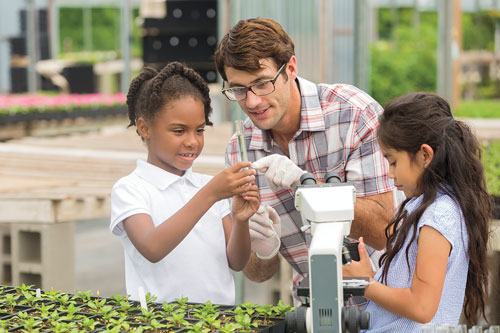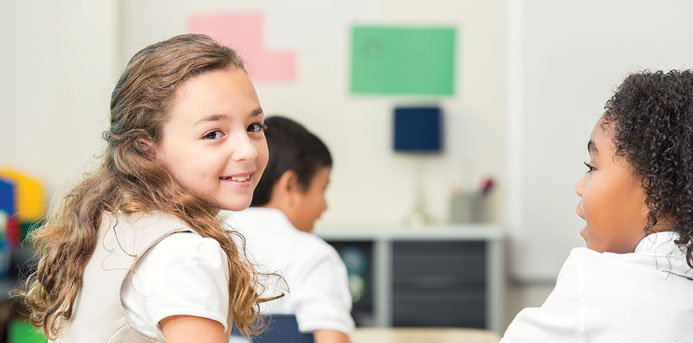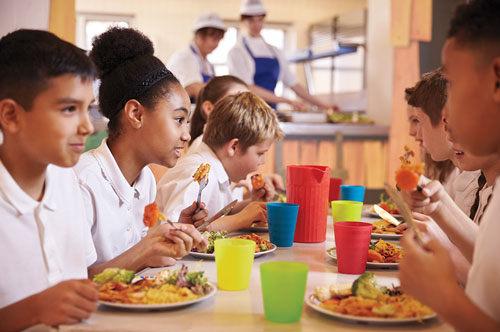This comprehensive guide covers everything you need to know about private schools in the Bay Area, in Marin and beyond.
When you’re thinking about your child’s education, it’s important to consider if a private school is the right fit. The guide below will help you come to understand what types of private schools are available, translate what different accreditations mean, and help you get acquainted with new innovations. In addition, Marin Magazine’s Bay Area Private School Guide Directory offers comprehensive listings with particulars on more than 160 private schools in San Francisco, Marin, Sonoma and Napa counties and the East Bay.
A Big Decision

When you’re selecting a private school, it helps to narrow the field by deciding what kind of school you want your child to attend. The following categories are not mutually exclusive; some schools may fit into two or more, such as St. Helena Montessori, a Montessori school that includes Catholic teachings. Even so, knowing how the main types of schools are defined will help you advance your search.
Independent Schools
These schools are governed by their own board. Some are secular, while others have a religious mission but are not part of or dependent on a specific church or temple. Independent schools in Marin County include Corte Madera’s Marin Country Day School, Mill Valley’s Marin Horizon School and San Rafael’s Marin Academy.
Catholic Schools
Although there are schools affiliated with most every religion, the Catholic school system is such a major institution — enrolling 38 percent of all private school students nationwide, according to the National Center for Education Statistics — that it deserves its own category. A Catholic school may be established and supported by a parish, a diocese or a private order such as the Jesuits or Franciscans. Not all families who choose Catholic schools subscribe to the faith; nationwide, 17 percent of their students are non-Catholic, according to the National Catholic Education Association. Catholic schools in Marin include Kentfield’s Marin Catholic High School, Novato’s Our Lady of Loretto School and Tiburon’s Saint Hilary School.
Non-Catholic Religious Schools
If you add up all the other types of religious schools — conservative Christian, Jewish, Lutheran, Seventh Day Adventists, Quaker and others — they enroll about as many students as Catholic schools do, nationwide. Non-Catholic religious schools in Marin include San Rafael’s Brandeis Marin (Jewish) and Good Shepherd Lutheran School and Marin Christian Academy, both in Novato.
Montessori Schools
This approach to education has been around for more than a century, but it has enjoyed a surge in popularity in recent decades as parents increasingly embrace Montessori’s focus on the whole child, with independent activities and materials that appeal to kids’ senses. The North American Montessori Teachers Association estimates there are about 4,500 Montessori schools in the United States, most of them private. Maria Montessori originally developed her teaching philosophy for preschoolers, and the majority of Montessori schools still focus on early childhood education, but some include elementary and even secondary grade levels. Montessori schools in Marin include Corte Madera’s Marin Montessori School and San Rafael’s Montessori de Terra Linda School.
Waldorf Schools
Less common than other private school models, with only about 150 schools in North America according to Waldorf Answers, this is nonetheless an attractive educational philosophy to many progressive parents. Waldorf is sometimes categorized alongside Montessori since both allow students to move beyond the desks and worksheets of today’s mainstream classroom. However, Waldorf schools in practice are fairly distinct from Montessori. Students in a Waldorf school may spend more time creating things, whether it’s artwork or knitting with wool. Another distinguishing factor: Waldorf schools don’t teach academics until first grade. For more on what defines Waldorf, see this article on Waldorf versus Montessori.
Alphabet Soup: Accreditation Organizations
AIS, NAIS, NCEA, WASC — a list of private schools can look like a jumble of radio call signs to the uninitiated. What do all these letters mean? Many of them represent the organization that accredited the school — the folks who examined the school to make sure it meets standards. The accreditation process is a lot like peer review for a scientific paper: educators or administrators from outside the school come in to audit how the school functions and suggest ways it could improve. Here’s a look at the most common acronyms used to describe Bay Area private schools, including organizations and the accrediting bodies evaluating schools.
While accreditation is optional for private schools under California law, it’s a good idea for parents to make sure their school of choice has been examined by at least one recognized accrediting organization. Besides assuring parents that the school they’re enrolling their child in meets standards and goals set forth in the organization’s guidelines, accreditation also ensures that the academic credits will transfer if your child changes schools. Schools may be accredited by more than one organization.
The Western Association of Schools and Colleges (WASC) accreditation is required for all public schools in California; many private schools seek WASC accreditation as well. Private schools with WASC accreditation include Fusion Academy Marin, Our Lady of Loretto School, Brandeis Marin, Marin Primary and Middle School, and Marin Academy.
You can view a full list of WASC-accredited schools at the directory on the WASC website. WASC is one of six regional accrediting agencies in the United States, and its accrediting commission is composed of representatives from educational organizations such as the Association of California School Administrators, the California Teachers Association and the California Association of Independent Schools. WASC advocates a student-centered approach and encourages staff to improve through continuing education.
Formed in 1941 by educators concerned that not all private schools were producing graduates meeting the standards of the University of California, the California Association of Independent Schools (CAIS) today has 219 member schools, just under half of them in Northern California, and serves as the accrediting organization for independent nonprofit schools in California. CAIS’s accreditation process involves both an in-depth self-study on the part of the school and a school visit by a team of educators to make sure the school is adhering to standards and continually improving. “The standards address all areas of school life, including the following: mission, governance, finance, program, community of the school, administration, development, admissions, personnel, health and safety, facilities, student services, school culture and residential life (where applicable),” the CAIS website says. In Marin County, CAIS-accredited schools include Marin Horizon School, Mount Tamalpais School, Marin Country Day School, Marin Montessori School, Marin Primary and Middle School, San Domenico School, Brandeis Marin, The Marin School, Mark Day School, The Branson School and Cascade Canyon School. CAIS is devoted to maintaining “standards without standardization,” noting on its website, “Because each school community is unique, the accreditation process permits the school to use considerable flexibility in its approach to the self-study yet still be linked to sound components of a quality self-assessment.”
The National Association of Independent Schools (NAIS), formed in 1962, is not an accrediting authority but a membership organization providing services to more than 1,800 independent, private, nonprofit K-12 schools and associations of schools (such as CAIS) in the United States and abroad. Most private independent schools in the Bay Area belong to NAIS.
More so than with other kinds of schools, the letters that come after the name of your Montessori school can tell you what philosophy the school likely embraces.
The Association Montessori Internationale/USA (AMI) is the domestic branch of the original organization founded by Maria Montessori; schools that list AMI recognition cleave closely to Montessori’s original methods, and every classroom has a head teacher trained by the organization. In the Bay Area, AMI/USA recognizes Corte Madera’s Marin Montessori School and San Rafael’s Montessori de Terra Linda School.
Schools accredited by the American Montessori Society (AMS), formed in 1960, may have teachers trained by a number of Montessori organizations. These schools have more freedom to supplement Dr. Montessori’s methods with other resources and ideas — although they still must maintain Montessori practices such as self-directed learning based on kids choosing, using and then putting away materials. In the Bay Area, AMS-accredited schools include Brush Creek Montessori School in Santa Rosa and Petaluma’s Spring Hill Montessori.
The Western Catholic Educational Association (WCEA) is the main organization accrediting Bay Area Catholic schools, including Santa Rosa’s Cardinal Newman, San Anselmo’s St. Anselm School and Larkspur’s St. Patrick School. WCEA’s directors and members include representatives from archdioceses and dioceses all over the western states, and it accredits both elementary and secondary schools to ensure they are performing well on two fronts: faith formation and educational excellence.
You may also see the letters NCEA listed with a Catholic school’s name; they stand for National Catholic Educational Association, which is a membership group but not an accrediting body.
Education Innovations

New education concepts are offering students experiences they couldn’t find in a traditional classroom setting.
This spring, some Marin Academy students will have the chance to visit social media companies, led by their entrepreneurship teacher, who is on the faculty of the Athenian School in Danville. Others may meet online with students from Athenian or the Urban School of San Francisco for multivariable calculus study sessions, while still others may attend film festivals with their cinema teacher from Lick-Wilmerding, then upload their own videos to share with classmates across the Bay Area.
All these courses and a few more are offered as part of the San Rafael high school’s participation in the Bay Area BlendEd Consortium, a prime example of how innovative schools are combining the benefits of technology and one-on-one instruction in a blended or hybrid education model.
Using videotaped lectures and teleconferencing allows Marin Academy to pool resources with four other independent schools to offer classes in niche interests that the 410-student school couldn’t cater to on its own, says Liz Gottlieb, a biology teacher who coordinates the program at the school. But it’s not all staring at a screen: in several in-person meetings per term, the kids have experiences a traditional course wouldn’t allow time for. In her Bay Area Field Ecology class, Gottlieb will take students camping at Point Reyes, and they will work with naturalists to gather data in the field.
“It’s both independent and extremely facilitated through the learning management system and these trips,” Gottlieb explains.
The efficiency of blended learning, which allows students to study at their own pace and spend less time in class, is one of its greatest benefits, educational consultant Jan Keating says. “The hybrid learning environment is an efficient use of time, which gives kids more time to be creative and use what they’re learning.”
Keating, who helped create Stanford Online High School and Santa Cruz’s Pacific Collegiate Charter School, is working with developer North Coast Land Holdings to propose a hybrid prep school for the site of the former Golden Gate Baptist Theological Seminary in Strawberry. This concept, put forward after the Branson School of Ross dropped its bid to expand there, would serve both local students and boarders and would combine videoconferencing and other technology with on-site resources such as a maker lab or film studio to create an elite school with a highly individualized curriculum, Keating says.
One reason hybrid education can be so personalized is that prerecorded lectures can be watched over and over by students who need the repetition, or skipped by students who already know the concept, she says. Then there’s the advantage that the lectures can be delivered by people other than high school teachers.
“You can get top people in their fields lecturing on specific topics. They only do it once, then you’ve got it,” Keating says.
Hybrid or blended education is just one type of educational innovation being seen in independent, private and parochial schools in Marin. Among the others:
Project-Based Learning
A major innovation in 21st century education is PBL, which Marin’s own Buck Institute for Education defines as “a teaching method in which students gain knowledge and skills by working for an extended period of time to investigate and respond to an authentic, engaging and complex question, problem, or challenge.”
The efficiencies and flexibility of hybrid or blended education lend themselves to PBL, but this innovation is also being embraced by schools independent of technology use.
Just two of many examples: K-8 Jewish day school Brandeis Marin, in San Rafael, lists PBL as one of its core educational pillars, noting that it “fosters creativity, critical thinking, collaboration and problem solving.” Mark Day School, also in San Rafael, incorporates PBL into its first-grade curriculum when students create worm bins to process compost and then create books to educate others about vermicomposting.
“We don’t want to just focus on lecture format, where the teacher’s just giving all the information and the kids are memorizing it and taking a test,” says Raquel Rose, assistant superintendent at the Marin County Office of Education. “Project-based learning is more about focusing on the 21st century skills of collaboration, communication, critical thinking and creativity.”
Student Leadership
While having a student council is nothing new, schools in today’s Marin give student leaders more opportunity to really work out serious issues they and their peers face.
“The old way of doing things was, as the teacher or the guidance counselor, you would identify for the kids what the problem was and coach them through trying to solve it,” Rose says. Now kids are being allowed to call out problems themselves and brainstorm solutions.
In February, students from both private and public Marin schools had the chance to compare notes at the first Marin County High School Leadership Summit, organized by Rose’s office.
“When you take the leadership group from Marin Academy and join them with the leadership group from Redwood and San Domenico, here’s a group of leaders who can come together and say, ‘Here’s what we did at our school,’ or ‘How could we emulate that or make it work for our school?’” Rose says.
Outdoor Education
Dovetailing with the trend of less seat time and more projects and independent or collaborative thinking is the increasing prominence of outdoor education in Marin schools. Throw in Marin’s irresistible outdoor landscape, and it’s not surprising that so many independent schools tout the amount of time students spend in nature. Schools frequently credit their forays into the outdoors with building students’ self-reliance as well as fostering cooperation and community.
“The fall overnight trip focuses on hands-on outdoor learning and environmental education. The students learn to work together as a class and form strong connections with their teachers and peers,” reads the website of Fairfax’s small Cascade Canyon School.
Novato’s Good Shepherd Lutheran School works outdoor education into the academic curriculum from fourth grade on. Fourth graders spend two nights at Coloma Outdoor Discovery School, near a historic mining town, to flesh out their understanding of California history, and fifth graders spend four nights conducting outdoor science activities in the Santa Cruz Mountains.
Check out Marin Magazine’s Bay Area Private School Guide Directory for more information.
This article originally appeared in Marin Magazine.


